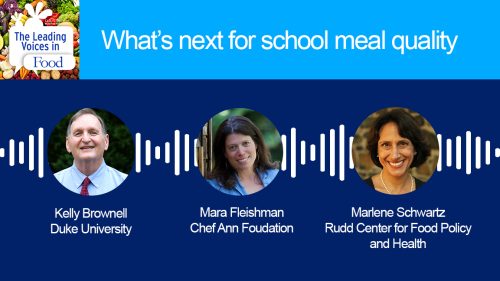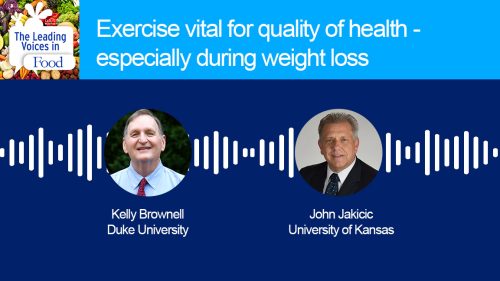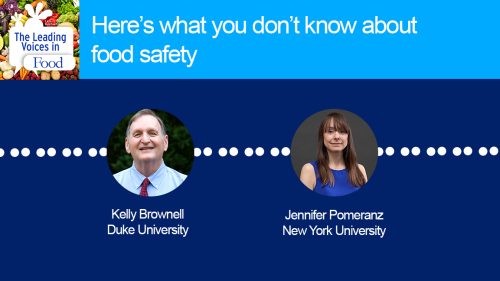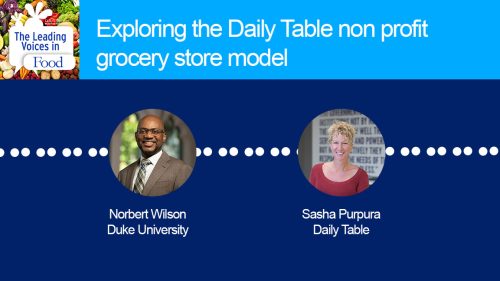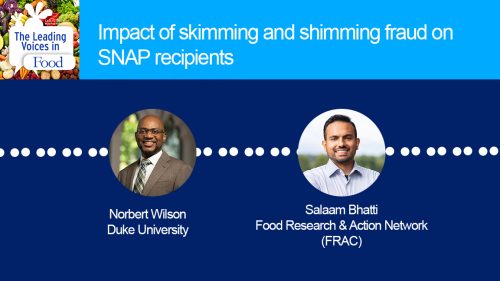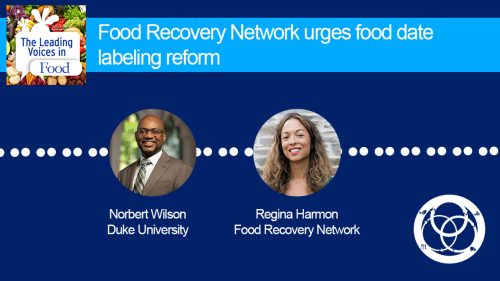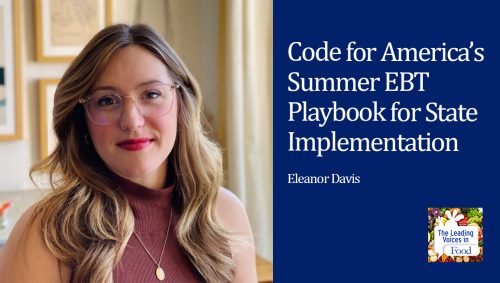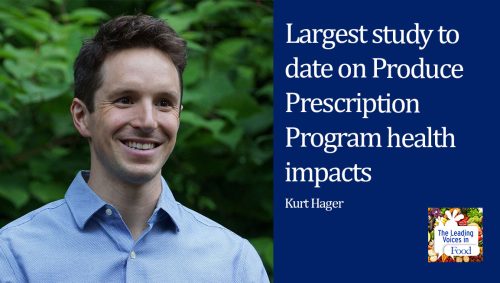E233: Grocery and meal insight from the Baby’s First Years project
A growing number of research studies show that the cognitive and brain development of low-income children differs from that of children in higher income families. For any family, that is a concerning statement. Today’s podcast features a project called Baby’s First Years, a multi-year effort to test the connections between poverty reduction and brain development among very young children. Here to talk about what the study has revealed so far is Dr. Lisa Gennetian from Duke University’s Sanford School of Public Policy, and Dr. Sarah Halpern-Meekin from the La Follette School of Public Affairs at the University of Wisconsin, Madison.
Subscribe: Apple Podcasts | TuneIN | YouTube Music | SoundCloud | PocketCasts | Radio Public
Tags: Child Development & Nutrition | Diet & Nutrition | Food Insecurity | Social Safety Net & Food |

Dr. Lisa Gennetian is an applied economist, Professor of Public Policy, and the Pritzker Professor of Early Learning Policy Studies at Duke University’s Sanford School of Public Policy. Drawing on perspectives from the behavioral sciences, psychology, and child development, her research focuses on the economics of child development, specifically child poverty, parent engagement and decision making, and policy and social investment considerations.
Dr. Sarah Halpern-Meekin is Vaughn Bascom Professor of Children, Family, and Community in the School of Human Ecology and the La Follette School of Public Affairs at the University of Wisconsin-Madison. She is also an affiliate of the Institute for Research on Poverty. She is a sociologist whose research focuses on family, adolescence, social policy and the welfare state, class and inequality, and qualitative methods. Her current research includes examining the role of parents’ churning (on-again/off-again) relationships in family life, exploring the experiences and financial decision-making of mothers who are receiving monthly unconditional cash gifts, and understanding how rural men make ends meet, spend their time, and make meaning while disconnected from the formal labor force
Transcript
Sarah, let’s start with you. What is the Baby’s First Years study?
Sarah – So the Baby’s First Years study is a study of how having additional income matters for children’s development and for family life in families that had incomes around the federal poverty line when they had a child. And so, it includes two main components. The first is a randomized control trial that tests the effects of families receiving either a large or a small monthly cash gift each month, families get either $333 or $20 each month on a debit card from the time their child was born until just after the child’s sixth birthday. Lisa and our colleagues, Katherine Magnuson, Kimberly Noble, Greg Duncan, Hiro Yoshikawa, and Nathan Fox lead this part of the study. They’ve been following mothers and children from a thousand families over the past six years. The other part of the study is a qualitative study in which we do in-depth interviews with a subset of those families because we want to learn more about how they think, about making financial decisions, the values and dreams for their children that guide their parenting and how they think about their money they’re getting from Baby’s First Years each month.
This study is complex and would require time to observe change. Can you tell me about the length of time your team has been doing this intervention?
Sarah – So the first families started the study in 2018.
Lisa – One thing that’s unique about this intervention is its length. As Sarah mentioned, it’s starts at the time of birth and it’s monthly. And families will be receiving this cash for 76 months. So, they’ll be receiving it through the first six years of their child’s life.
Thank you for that detail. Lisa, what is the landscape for food programs and assistance in the United States, particularly for families with infants and young children?
Lisa – There are two major programs that are federally funded in the US that are particularly targeted for families with infants and children. One of them is called the Women, Infant, and Children’s Program, or WIC for short. The WIC program, let’s see, in 2022, served about 6.3 million participants, but it provides a mix of core nutritional needs, breastfeeding support, information and referrals. And the second big safety net program in the US around food is called SNAP, Supplemental Nutrition Assistance Program. This one’s broader and has served over 40 million people in 2022. And together both these programs have been pretty core to providing food and nutritional support to families, including those with young children.
Thanks for that context. So now, how does the cash gift intervention differ from, or fit with other food assistance programs that these families may participate in?
Lisa – The thing that cash can add above and beyond that, so thinking about how this Baby’s First Year study might help supplement resources is in two ways. One is thinking about how money that might have been spent on the foods that are provided by these programs are now being taken care of through these food subsidies. One direct way that the BFY cash money can help is by increasing those net resources available for other types of food or for other things in the household. It’s a real compliment to these what we call in kind or conditioned kind of food subsidy programs. The second is that there are no conditions. And so, what WIC and SNAP provide, which is really formative and really important for a lot of families, is also has some real parameters on what could be purchased. And so having extra cash means sort more flexibility around direct food resources. And that’s actually something we start to see a little bit in the Baby’s First Year study.
Wow, Lisa, thank you for that. Given that these are means-tested programs, the cash infusion from Baby’s First Year’s project could influence participants’ eligibility for other programs, right? How did you deal with that?
Lisa – Oh yes, it’s a really great question. Thanks for asking that. For the purposes of this study, we, for several years, worked closely with all layers of government, federal, state, and local to think hard about how to protect the families receiving this cash gift from losing eligibility for these other programs because as you say, right, we’re increasing their income implicitly through this cash gift. And so, we did that through some administrative rulings, meaning states agreed that the families would be exempt and to the states, we had legislation passed to protect these families from their eligibility being affected by receipt of the cash gift. We did that as comprehensively as possible. There are some exceptions, but we think that it’s been pretty effective kind of strategy we use to ensure that families, when they get this cash gift, that they’re not mechanically losing eligibility for these other programs. So, the way to think about this cash and supplementing people’s lives and supplementing and accompanying everything else, is also helping how families might think about access to these other programs and choices around that in ways that they might not have had before.
That sounds like a large undertaking, and it took extensive planning to get to that point. I imagine you wouldn’t want families to lose their benefits because they participated in this study. Sarah, I want to come back to you. What are families’ experiences with Baby’s First Year and with government-provided food assistance programs in the United States?
Sarah – So families in both gift groups are appreciative of having extra money every month. That’s even more so the case for those in the high gift group mothers not surprisingly, some mothers in Baby’s First Year struggle to make ends meet, for others, even if they can cover their bills every month, having just that little bit extra breathing room is pretty welcome. Like Lisa was talking about across the country, in Baby’s First Years, the vast majority of families have experience with food assistance programs, either currently or in the past. It’s pretty rare for them not to, relatively speaking, while families often receive WIC, that’s the Women, Infants and Children program that Lisa mentioned, when they have babies, many stop getting WIC after their babies turn one, despite the fact that they remain income eligible for that. Most families also receive some benefits from SNAP. And in some qualitative work that I did with my colleagues, Carolyn Barnes and Jill Hoiding, we heard from families about how they thought about engaging with the WIC program. They thought about the value of the benefits they could get from doing so, but also the costs of doing that, like how hard it is to make it to appointments, to fill out the paperwork to use those benefits once you’re at the grocery store. And they weighed those costs and benefits as their children grew up when they were thinking about whether or not to pursue those benefits.
So Lisa, what are you learning from the Baby’s First Year study about where and how families and children are getting food?
Lisa – So Sarah has talked about the richness of speaking to moms directly at holistic types of interviews. Alongside that, we’ve annually been going back and speaking to mothers and collecting information about them and their children. And part of our, so these are our annual surveys, they are in or near the children’s birthdate, and we ask them a bunch of questions about how life is going, about their spending, what’s happening with income and employment and childcare, their own health, their mental health. One of the areas that we focus on is around food. And one of those food items is called a food security scale. This is a six item, a USDA-approved scale. It asks questions like not having enough money to buy food, questions about hunger, questions about eating balanced meals. It includes a set of items that we would call pretty subjective. For example, the question on balanced meals, but also less subjective. Is there literally enough money to buy enough food for the household? And so, we’re learning some really interesting things. First, we’re learning that there is very high connection to this food safety net that we were just talking about. So, far majority of the families are connected either to WIC or the food assistance program called SNAP. And that’s pretty consistent. Sarah just talked about a little bit of the drop off of WIC, but we certainly see consistent connections to SNAP, all the way through the first three years of the child’s life. We see that generally as sort of a kind of good news story. So, these are families who are eligible for these programs, their family’s drawn from four very different dates and sites. They’re very diverse in their racial ethnic composition and whether they’ve been born or not in the US in terms of the moms. The fact that there is very high connection to a food safety net system while raising young children, we think is a really positive signal of the food safety net system potentially working pretty well. And then we’re not seeing big differences between the high cash gift group and the low cash gift group on this food security measure. In fact, we’re seeing pretty high food security amongst these families with very young children on the scale. That doesn’t mean that any one of these items, we’re not seeing high reports of things like scarcity. So even though the families are very low in food insecurity, we do see that about a third of them are reporting some kind of food scarcity. So, 31% report that the food they bought did not last and they sometimes often didn’t have money to get more. For example, we’re also hearing from families, they’re relying on free meals from non-federal sources. We haven’t talked yet about the importance of the faith-based kind of system and support and informal networks in providing food. We ask families this when their children were about three years old, and roughly 10% report some receipt of free meals from other sources. We are inevitably also seeing, as you might expect, some variation across these sites. So that’s sort of a hint on what we’re seeing around food security and connections to the safety net. We also ask about spending, and we’re not seeing overall differences in how much money is being spent on food with one very interesting exception. That’s on money, on food spent eating out. We don’t ask a whole bunch of information about nutrition, but when the children were toddlers, moms do report, who are receiving the high cash gift, they do report higher consumption of fruits and vegetables among their toddlers. It is a very sort of unique and narrow question, but positive, so more fruits and vegetables and not more of other things like salty treats, flavored drinks, sodas, sugary sweets. And we’re looking forward to continuing to follow up on items of nutrition when the children are four.
This is fascinating, and I’m so grateful that your team is paying attention to these families’ experiences and engagement with the social safety net and the charitable food sector. Sarah, we often understand food, particularly healthy food, as a way to deliver nutrition that promotes health and development. Of course, food provides much more than nutrition. What, if anything, are you learning from the study about the social meaning of food and what it represents to families?
Sarah – I really appreciate this question because it’s something we’ve been looking at and thinking about a lot in our research, in the research other people have done before, and in our own study we really hear a lot about the role that food plays in families, beyond nutrition. In so many cultures, food plays a really core role in social time and in family time. This can be things like turning family movie night into something a little more special by microwaving popcorn. It can be having special mom and me time with mom taking a child out to go get a cake pop at a coffee shop. It can be eating a meal at a sit-down restaurant to celebrate a special occasion, a child’s middle school graduation, for some of these purchases, you can’t use food assistance. And so having cash on hand is really essential to engaging in these kinds of special rituals and family time. Like your question implies, it turns our attention to the role that food plays in family bonding and in socializing. We really want to think about the multiple roles that food serves in our lives and how having this kind of extra income on hand for families who are often income constrained, can change these opportunities for those special family times around food.



